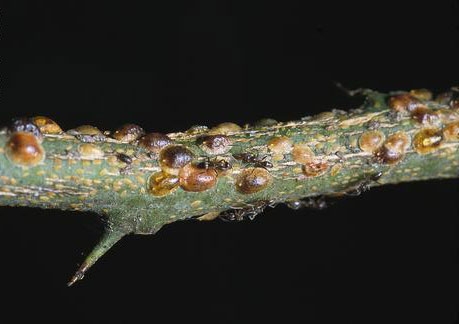Posts Tagged: chlorpyrifos
UC IPM providing helpful information on chlorpyrifos situation
Farmers gathered at the UC Kearney Agriculture Research and Extension Center in Parlier yesterday to discuss potential action by the EPA on the insecticide chlorpyifos, reported Ezra David Romero on Valley Public Radio. The meeting was hosted by UC Agriculture and Natural Resources (UC ANR) Statewide Integrated Pest Management project (UC IPM).
Chlorpyrifos is widely applied to many crops for pest control; the highest percentage on almonds, citrus, alfalfa and cotton. However, the U.S. Environmental Protection Agency has proposed cancellation of its use in agriculture.
"Chlorpyrifos is a tool and over reliance on that tool to help us solve pest problems is going to have environmental impacts and potentially could impact human populations as well," said UC ANR Cooperative Extension advisor David Doll in the Valley Public Radio story.
Romero also spoke to Selma almond grower Bill Chandler at the meeting.
"Don't give up the ship, there's help," Chandler said. "That's why they (UC IPM) had this meeting to say, listen gentlemen, there's these problems. Let's learn how to work with them and see what we can use differently."
More UC IPM meetings on the issue will be held in the coming weeks at the following locations:
Jan. 12 – Citrus in San Joaquin Valley
8 a.m. to 12:00 p.m.
UC ANR Cooperative Extension office, 4437 S. Laspina St., Tulare
Jan. 21 – Alfalfa in Imperial Valley
8 a.m. to 12:00 p.m.
Farm Credit Services Southwest, 485 Business Parkway, Imperial
Jan. 26 – Almonds in Southern San Joaquin Valley
8 a.m. to 2:30 p.m.
Kern County Agricultural Pavilion
3300 E. Belle Terrace, Bakersfield
Feb. 5 – Almonds in Northern California
8 a.m. to 12:00 p.m
Chico Masonic Lodge, 1110 W. East Ave., Chico
For more information contact Lori Berger, UC IPM chlorpyrifos project coordinator, at lberger@ucanr.edu or (559) 646-6523.
UC scientists help clarify use of insecticide
The report, Identifying and Managing Critical Uses of Chlorpyrifos in Alfalfa, Almonds, Citrus and Cotton, was commissioned by the California Department of Pesticide Regulation (CDPR) earlier this year and submitted by UC IPM in October 2014.
“We feel the department entrusted UC IPM with this task because of its reputation for developing effective IPM systems and its track record in bringing groups together to address challenging issues,” said Pete Goodell, UC Cooperative Extension advisor for integrated pest management and report principal investigator. Lori Berger, also of the statewide IPM program, was the project coordinator.
To gather input for the report, Goodell and Berger formed four “crop teams” with leaders from the alfalfa, almond, citrus and cotton industries. While chlorpyrifos is used in many of California's more than 300 crops, these four crops were selected due to the amount of acreage treated and insecticide use patterns. Combined, these commodities are grown on about 2.5 million acres and valued at more than $10 billion per year in California.
Chlorpyrifos is a common insecticide used under the trade names Lorsban, Lock-on and generic formulations to control ants, stink bugs, aphids, whiteflies and other pests. The report details the insecticide's use patterns as compared to other pest control tactics, such as resistant varieties, mating disruption, field sanitation and other insecticides.
“Our industry teams told us that chlorpyrifos is an essential component of their IPM programs,” Goodell said. “The teams believe decision support tools would be useful to help pest control advisers and growers recognize the critical use scenarios that require its application.”
As a part of the discussions, the teams asked that CDPR develop comprehensive, science-based information about the specific risk pathways posed by chlorpyrifos and work with the industry to develop any new application safety measures. The representatives of the agricultural community also asked that new human health data from the U.S. Environmental Protection Agency be considered in future CDPR regulatory decision-making to ensure that the most current data available informs their decisions.
For the second phase of the project, UC IPM will hold outreach meetings in 2015 and 2016 for pest control advisers, UCCE farm advisors, commodity group representatives and farmers who grow alfalfa, almonds, citrus and cotton.
“There is a new generation of professionals coming into the field,” Goodell said. “UC's IPM Program is well-prepared to equip them with decision-making tools that include a wide variety of insect management options.”
The full report can be found on the CDPR website: http://cdpr.ca.gov/docs/pestmgt/crit_uses.htm
An initiative to manage endemic and invasive pests and diseases is part of the UC Division of Agriculture and Natural Resources Strategic Vision 2025.
Pesticide exposure linked to lower intelligence
Children who were exposed to certain types of organophosphate pesticides before birth could have lower levels of childhood intelligence, according to a UC Berkeley study reported on by the Salinas Californian.
The study examined the effects of pesticide exposure in the Salinas Valley for more than 10 years. The researchers, representing UC Berkeley and the Center for the Health Assessment of Mothers and Children of Salinas, found that every 10-fold increase in the amount of the pesticides found in the mother during pregnancy corresponded with a 5.5 point drop in IQ scores when the children were 7.
"These associations are substantial, especially when viewing this at a population-wide level,” a UC Berkeley news release quoted principal investigator Brenda Eskenazi, professor of epidemiology and of maternal and child health. “That difference could mean, on average, more kids being shifted into the lower end of the spectrum of learning, and more kids needing special services in school.”
The UC Berkeley study is one of three showing an association between pesticide exposure and childhood IQ published online April 21 in the journal Environmental Health Perspectives, the news release said.
Mt. Sinai researchers sampled pesticide metabolites in maternal urine, and researchers at Columbia looked at umbilical cord blood levels of a specific pesticide, chlorpyrifos.
“It is very unusual to see this much consistency across populations in studies, so that speaks to the significance of the findings,” said lead author Maryse Bouchard, who was working as a UC Berkeley post-doctoral researcher with Eskenazi while this study was underway. “The children are now at a stage where they are going to school, so it’s easier to get good, valid assessments of cognitive function.”
The Los Angeles Times reported that some of the data are not as conclusive as they might seem at first glance.
". . . Let’s be cautious—the IQ differences were small, and some only appeared by looking at the data in a certain way," said the article written by LA Times reporter Marissa Cevallos. "Women in the Berkeley study, for example, had their urine measured for traces of pesticides twice—once in the first half of pregnancy and once in the second half. The researchers found no correlation between IQ and pesticide markers in the first urine test or in the second urine test. But then when they averaged the two, voila—a correlation."
The story was picked up widely by the news media, including:

Organophosphate pesticides are approved for use in agriculture. Increasing evidence suggests that prenatal exposure to pesticides may have health impacts in later years.



